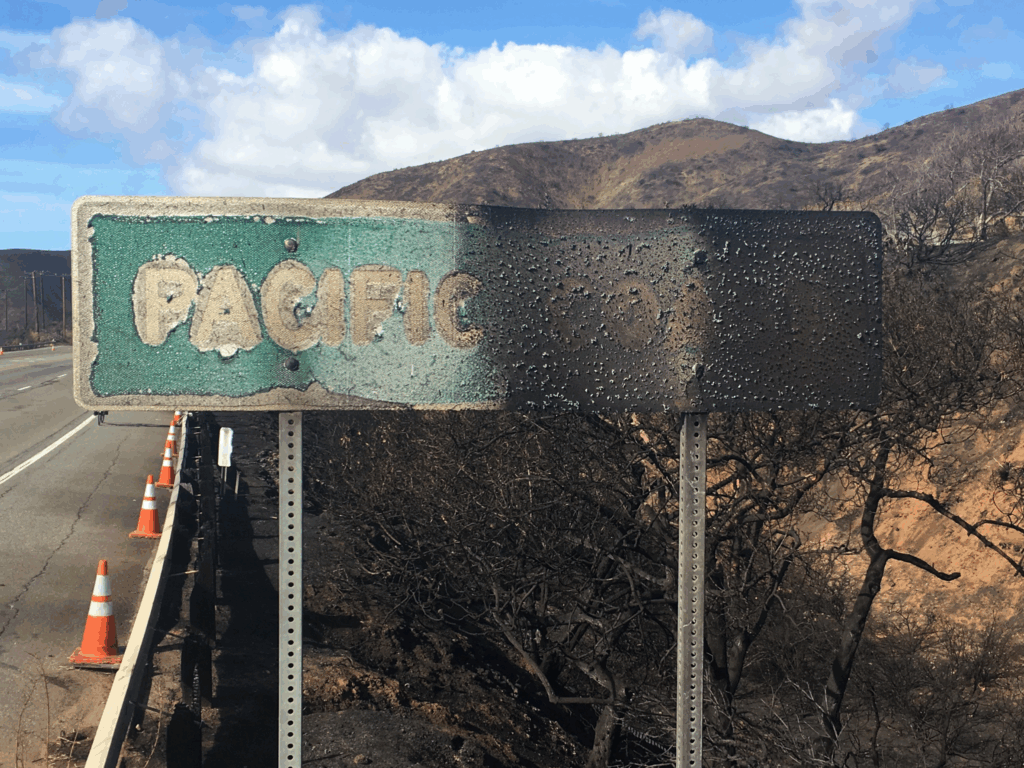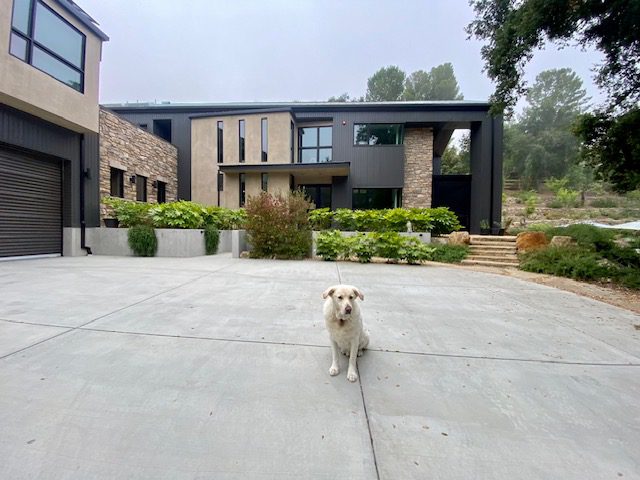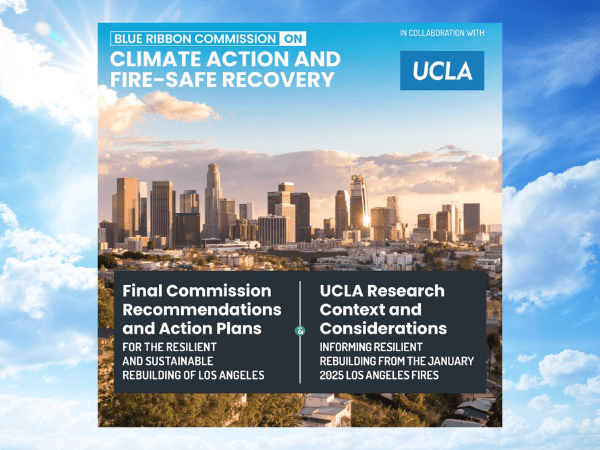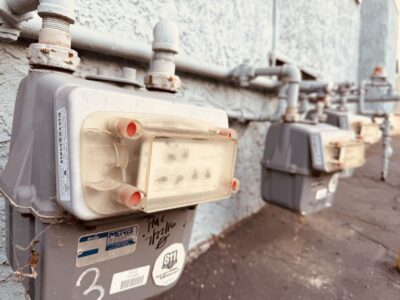What Have We Learned About Rebuilding from Fire?
Woolsey Fire survivors reflect on the rebuilding process and what might help rebuild more resiliently after the January fires.

When I first met Nicole Fisher in 2019, her property in the Santa Monica Mountains was nothing but a driveway and a pile of cement.
I was interviewing the art teacher for a radio story about her family’s plans to rebuild after the 2018 Woolsey Fire that destroyed her home and hundreds of others in Malibu. At that time, Malibu was still reeling. As we talked, her dogs ran circles around the property, like they were searching for their missing house.
Six years later, I checked in with Fisher and others to ask how things went and what might have made the rebuilding process better. I was curious how their observations would line up with the recommendations of the Blue Ribbon Commission on Climate Action and Fire Safe Recovery. The commission, which my Emmett Institute colleagues supported as part of a UCLA research team, recently released a final report on how to recover after the devastating January fires in Altadena and the Pacific Palisades.


The first decision Fisher faced was whether to rebuild at all. “We traveled the country in a trailer for the summer of 2020 to reassess and rethink on the road,” she told me. “We drove home and decided to rebuild and see it to the end here.”
Fisher and her husband built a new house on the property and they love it, but it hasn’t been easy. Fisher said they obtained their building permit in February 2020. It was 2 years until they moved in and another 2 years before they completed all the related projects. “Only now, 6 years in, do we feel back home and settled,” she said.
Not everyone in the neighborhood has joined them. Less than half of the homes destroyed by the Woolsey fire have been rebuilt at last tally. Some owners blame red tape; others chose not to rebuild for various reasons. So, what lessons did they learn along the way?
“I wish there was a fire hardening resource manual”
“The tiny house was a win,” Fisher said. They purchased a single wide, 400-square-foot trailer that cost much less than renting an apartment. They installed it on the property while they went to work obtaining an architect, a contractor, and a building permit. They designed a new home that was only 10% larger than the original house, which exempts property owners from coastal permitting requirements after a natural disaster. With tips from their architect, they opted for fire hardening features, including metal siding, a metal roof, and less vegetation around the house. “I wish there was a fire hardening resource manual with the latest and greatest information,” she said. They installed solar panels and more efficient appliances, but kept their propane gas tank.
Like many people in their situation, Fisher’s family hit a roadblock in the permitting process. And like most people, the roadblock was seemingly unique to their situation. It had to do with the fact that their property was technically 2 separate parcels. It took months to resolve. Then there was the dispute with the metal siding subcontractor who claimed they needed an additional $50,000 for materials, which they had to sort out. Fisher says they were also surprised to learn they needed to increase their water access to strengthen water pressure for sprinklers — at a significant cost — even though the home was only slightly larger. Overcoming these obstacles required the assistance of not just their builder but their neighbors who were lawyers and architects. Having some kind of rebuilding ombudsman who could help people evaluate the challenges and opportunities of their situation from the outset would have been invaluable, she said.
Still, they were in their new home relatively quickly. “I have students who are still not in their homes — some of whom were not even born when the fire happened, but their families are still displaced,” Fisher said. Were there any neighbors who rebuilt even more quickly?
Talk to Steve, she said.
“No one is going to be as interested in your rebuild as you are”
Steve Bernal, a recently retired mortgage broker, had some career experience managing properties. He secured a building permit in July 2019 and was in his new house by March 2020 — a year and a half after the Woolsey fire. Is that some kind of record?
“The number one problem for us was not having enough fire insurance. My wife and I just decided we were under-insured, so we were going to just jump back into it,” he told me.
Bernal said he understands that many people were too shell-shocked to make big decisions right away, but he said moving fast was the reason they quickly secured contractors and permits. “We rented a house within 5 minutes of the Calabasas office of the [LA County] building department. I wanted to be there at 7:30 in the morning when they opened, and I know that place very well now,” he said, adding that “no one is going to be as interested in your rebuild as you are.” Buying construction materials early paid off.
Bernal’s new home is also within the 10% expansion limit. It has solar panels, a sprinkler system, and other sustainability features but not as many as he’d like. They replaced their gas stove with an induction oven, but they too kept gas for heating and cooling and the water heater. “Knowing what I know now, I would have tried to steer toward all-electric,” Bernal said. “I would have done a heat pump system and electric water heater. We just didn’t know at the time.”
Looking at both his and Fisher’s rebuilding journeys, I see people who had to go it alone (except for the support of neighbors) competing in the market, and not always sure what building materials would be best for the future. Both struggled with insurance, the rising cost of building materials, and permitting surprises. Both were interested in climate-friendly housing features and might have gone even further if more incentives and resources were available.

“Recovery of our region must go beyond rebuilding”
Thousands of households in Altadena and the Palisades now find themselves in that same 6-month holding pattern that Nicole Fisher was in that day that I met her and her dogs in Malibu in 2019. So, what policies would help decide whether, and how, to rebuild?
“Bold, coordinated action is needed to counter the risks of displacement, rising insurance costs, and deepening community vulnerability to future climate events,” reads the final report of the Blue Ribbon Commission supported by UCLA. “Recovery of our region must go beyond rebuilding.”
The commission proposed more than 50 recommendations. They cover everything from building standards and vegetation management to make communities safer (and more insurable) to ways to support the rapid housing construction and workforce development that the region needs to rebuild. The commission has proposed two new overarching governance structures, a Resilient Rebuilding Authority and a Los Angeles County Fire Control District, that would help implement these recommendations.
I asked my colleague Julia Stein, who helped lead the UCLA research team supporting the commission, about how a Resilient Rebuilding Authority would function. Stein said the idea here is to create one single government entity whose primary authority is to manage recovery from the fires — and to be as interested in rebuilding as property owners. For individuals who are managing their own rebuilds, permitting will still need to go through the local jurisdictions, but there could be a number of benefits to a Resilient Rebuilding Authority. The RRA would act as a clearinghouse for information about permitting, design, landscaping, and materials as people weigh their options.
For folks who jump into rebuilding — like Fisher and Bernal did — the RRA would offer a central point of contact and accountability. Not everyone can show up at the building department front desk at 7:30 in the morning, after all. An RRA could also provide a mechanism for them to opt in to contracts. For example, Stein said, if the RRA is contracting with a homebuilder to build lots of homes at once, there may be an opportunity for property owners to opt in and take advantage of the cost efficiencies thanks to economies of scale.
Sadly, there are residents in Altadena and the Pacific Palisades who will decide they can’t, or don’t want to, rebuild. Many will sell their properties and move elsewhere. How do we ensure that it isn’t just a boon for private developers?
The RRA creates a government agency that can purchase, hold, and redevelop those properties en masse. That delivers cost benefits (mass contracting, purchasing of materials and labor), means that the RRA and not individual property owners will be the one that has to manage the permitting process, and gives the RRA the ability to offer a “right of first negotiation” to those who sold property to the RRA if they should want to move back after redevelopment is complete.
I asked Stein what that would look like in practice. The RRA would buy property from owners who are choosing not to build back themselves, redevelop the property, and then offer a right of first negotiation for that property, or possibly other comparable property in the area, to owners who sold to the RRA, she explained.
You can imagine how a rebuilding authority could streamline the process of installing community safety features. Say a number of property owners on one street decide they’re going to move rather than rebuild, and sell their property to the RRA. The RRA could then navigate the process of determining how that land is used and could interface with the local jurisdiction to rezone as needed so properties can be repurposed. This could help reimagine Altadena and the Palisades in ways that fire experts say are needed to be fire safe for the future. It could help those communities create strategic buffer zones, permanent escape routes and urban firebreaks.
This specific rebuilding proposal is gaining traction. A new bill called SB 549 by State Senator Ben Allen would authorize the creation of a Resilient Rebuilding Authority for the Los Angeles Wildfires.
The commission’s report also has an entire section of recommendations for how the city, county, and state should accelerate all-electric construction, educate stakeholders about those options, and provide incentives. This is important because energy-efficient, all-electric buildings powered by renewable energy reduce emissions, improve air quality, and can have lower construction costs than dual-fuel homes. Many Malibu homes could have been constructed without fossil gas lines or propane tanks if these policies were in place six years ago.
I didn’t ask Bernal and Fisher to weigh in on specific recommendations of the Blue Ribbon Commission. But I did ask them about the general idea of rebuilding with climate resilience in mind versus loosening environmental standards. Fisher said she found it disingenuous when elected officials promise to cut all red tape, “because that’s not reality,” she said. “They have to have permits, they have to build for the future of our environment.”
“I think that anything that has to do with hardening your home should be an absolute requirement,” Bernal said. He added that his homeowners association is looking at ways to require basic fire-hardening measures like adding vents to roofs, keeping trees trimmed, and clearing vegetation. “I do believe that at some point, if they’re not doing it already, the insurance companies are going to start looking at your entire neighborhood instead of just your house,” he said. “We need to look at how we as a neighborhood can make sure that if we have another fire event we have the best chance to make it through without losing property.”







Reader Comments